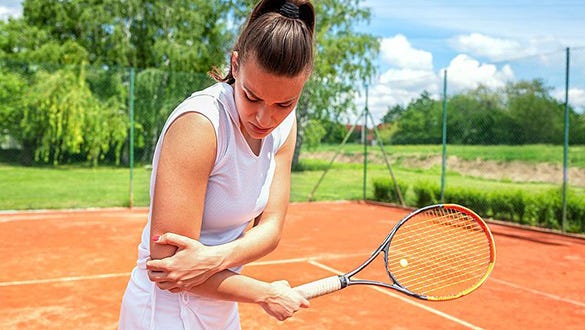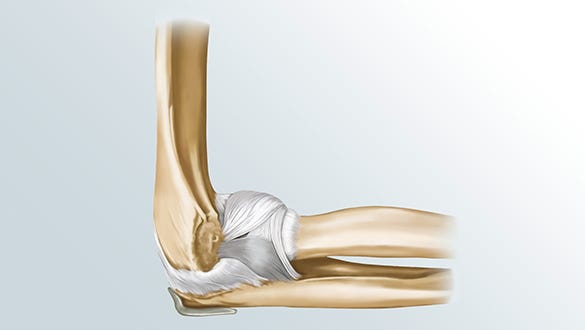- Säker onlineshopping
- Snabba leveranser
- Hög produktkvalitet
- Vårdpersonal? Klicka här
Armbågsluxation
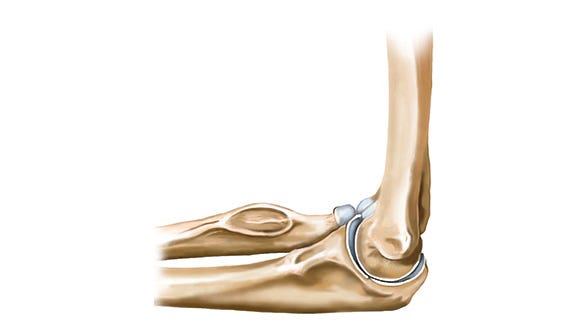

Kategorier
Instabilitet och luxation tillhör de vanligaste skadorna i armbågsleden
Vad är armbågsluxation?
De vanligaste skadorna i armbågsleden är ledluxation och instabilitet som ofta inträffar som en följd av luxationen. Efter axelleden är armbågsleden den led som ofta drabbas av luxation. Den vanligaste luxationen hos barn är armbågsluxation.
När armbågsleden förskjuts uppstår det ofta bristningar i de ligament som stabiliserar leden. Ledkapseln och musklerna har separerats från varandra. Beroende på luxationens omfattning kan de annars så tättsittande benen i leden flytta sig i förhållande till varandra. Det är framför allt det yttre kollaterala ligamentkomplexet, bestående av flera kollateralligament, som drabbas vid skador.
I diagrammet visas höger armbågsled sedd utifrån. Det visar också det yttre ligamentkomplexet, bestående av flera ligament, som kan slitas sönder vid en luxation.
I allvarliga fall orsakar luxationen både sönderslitna ligament och en fraktur på benet i ledstrukturen (armbågsluxation med fraktur). Det gäller överarmsbenet (humerus), strålbenet (radius) och armbågsbenet (ulna).
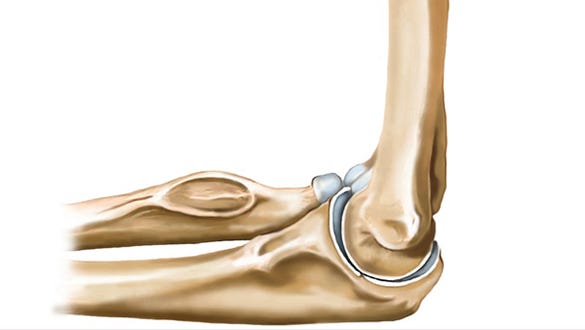

Instabilitet i armbågsleden
Instabilitet innebär att leden inte längre är stabil på grund av en skada i ledkapseln, ligamenten och musklerna och att den därmed har begränsad funktion. Det gör ont och ledbrosket kan vara skadat, vilket kan leda till prematur nedbrytning av ledbrosket (artros).
Orsaker till luxation och instabilitet i armbågsleden
Orsaken till armbågsluxation är olyckor där leden har utsatts för ett hårt slag. Instabilitet orsakas vanligen av ligamentskador. Det kan uppstå akut – vanligtvis efter en luxation (dislokation) eller fraktur (armbågsfraktur). I nästan en tredjedel av alla fall förblir leden instabil efter luxationen.
Symtom och tecken: smärta och svullnad
Om det förekommer luxation i armbågen, har leden förskjutits och rörelsen är begränsad. Patienten upplever svår smärta och armbågen är vanligtvis svullen. Ofta strålar smärtan ut i angränsande områden i kroppen. Om armbågsluxationen inte behandlas, kan det uppstå domnad och känselrubbning eller känselproblem som kan sträcka sig ut i armarna och händerna.


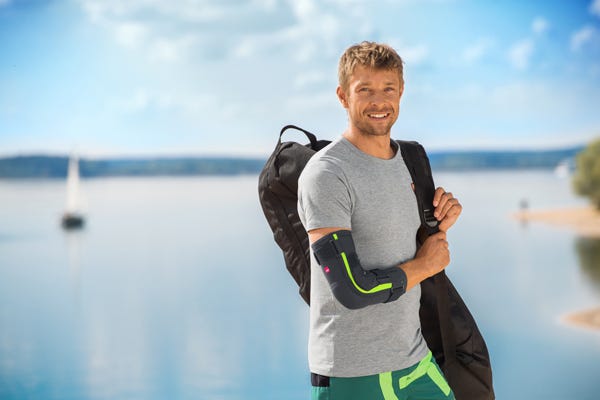

Riskfaktorer: Undvik frekvent upprepad belastning
En ofta återkommande belastning och/eller påfrestning, till exempel i idrotter där man har armarna över huvudet, kan leda till kroniska skador på ligamenten vilket resulterar i instabilitet. Instabilitet kan också uppstå som en följd av behandling med kortisoninjektioner eller operation i armbågen.
Förebygga luxation och försvagade leder
Eftersom det knappast går att förutse fall är det svårt att undvika det. Därför är det svårt att förebygga luxation i armbågen. Människor med medfödd instabilitet i armbågsleden eller med frekventa luxationer (som inträffar gång på gång när de rör sig eller tränar utan användning av våld) bör skona lederna från onödig ansträngning och undvika risker.
Behandling av luxation och instabilitet i armbågsleden
Benägenheten att utveckla ledstelhet är större i armbågen än i andra leder. Därför är det helt avgörande att luxation och instabilitet behandlas på ett tidigt stadium med hjälp av snabb mobilisering. Det är viktigt att den behandlande läkaren observerar patienten över tid så att behandlingen kan anpassas.
Produkter från medi
Behandling av luxationer
Behandling av luxationer: reposition av armbågen och efterbehandling
Den allra viktigaste åtgärden efter luxationen är reposition av armbågen för att undvika skador på framför allt på blodkärl och nerver. Detta görs vanligtvis på läkarkliniken efter föregående röntgendiagnostik.
Därefter måste typen av ledskada fastställas. Detta kan göras med magnetisk resonanstomografi (MRI), eventuellt även med datortomografi (CT).
Lätta ligamentskador kan behandlas utan operation (konservativt), ofta med stödförband.
Allvarliga skador måste vanligtvis opereras. Under operationen sätts benen ihop igen, och ligamenten sys ihop eller förstärks av andra senor.
Behandling av instabilitet
Behandling av instabilitet i armbågen
Behandlingsformen för lindriga fall av instabilitet är huvudsakligen fysioterapi. I allvarliga fall krävs en operation för att stabilisera leden och se till att den kan användas smärtfritt och för att förebygga ytterligare skada.
Fysioterapiövningar för behandling efter armbågsluxation
The treatment does not follow a fixed schedule, but must be individually adapted according to the patient's conditions. Therefore, discuss the exercises, variations and level of difficulty with your doctor or physiotherapist. Exercise also helps you return to sport after an elbow dislocation.
The muscles that stabilize the elbow are first trained separately. Other muscle groups can be integrated into more complex movement sequences during the course of treatment or if performed safely. It is useful to engage in dynamic exercises in the final phase before the patient returns to sport.
Träningen kan enkelt genomföras hemma och kräver endast vanlig hushållsutrustning. Övningarna bör genomföras tre gånger dagligen.
Steg 1: Isolering
Bicepscurls
Utrustning:
- Handduk
Startposition:
- Sittande på en stabil stol
Gör så här:
- Stick in handduken under knät.
- Ta tag i handdukens båda ändar.
- Lyft ditt ben genom att böja armbågen med handduken.
- Gör detta utan att sänka benet till golvet.
Variation:
- ingen
Frekvens:
- Du kontrollerar intensiteten genom trycket i ditt ben 1 set x 20 repetitioner 3 gånger dagligen
Underarmscurls
| Utrustning: |
- 1 kg hantlar alternativt en drickaflaska fylld med ca 1 liter vätska
Startposition:
- Sittande på en stabil stol
Gör så här:
- Lägg underarmen på låret.
- Se till att handflatan pekar uppåt.
- Vrid handleden uppåt.
- Låt sedan handleden sjunka ned igen mot låret.
Variation:
- Se till att handflatan pekar nedåt.
- Vrid handleden 180°.
Frekvens:
- 1 set x 30 repetitioner (10 repetitioner / variationer) 3 gånger dagligen
Stage 2: Integration
Framåtlutande hantellyft åt sidan
Utrustning:
- 1 kg hantlar alternativt en drickaflaska fylld med ca 1 liter vätska
Startposition:
- Stående
Gör så här:
- Stå stadigt och axelbrett isär med benen.
- Håll knäna lätt böjda.
- Böj din överkropp något framåt.
- Lyft axlarna och överarmarna åt sidan.
- Stretcha och böj dina armbågar.
- Genomför rörelsen endast från armbågarna.
Variation:
- ingen
Frekvens:
- 1 set x 20 repetitioner
- 3 gånger dagligen
Dips
Utrustning:
- ingen
Startposition:
- Sittande på en stabil stol
Gör så här:
- Luta dig mot en kant för extra stöd.
- Sänk ned dina höfter framför stolen.
- Lyft sedan rumpan genom att sträcka ut dina armbågar.
- Tummarna ska vara vända mot varandra.
- Håll knäna böjda.
- Håll kvar fötterna på golvet.
För ökad svårighetsgrad:
- Benstretch Stretcha höfterna och benen
Frekvens:
- 1 set x 20 repetitioner 3 gånger dagligen
Steg 3: Dynamik
Lyft vikter
| Utrustning: |
- 1 kg hantlar alternativt en dricksflaska fylld med ca 1 liter vätska
Startposition:
- Stående
Gör så här:
- Stå stadigt och axelbrett isär med benen och håll knäna lätt böjda.
- Lyft dina händer med hantlarna till brösthöjd.
- Se till att handflatorna pekar uppåt.
- Sträck dina armar rakt ut.
- Vrid dina handflator 180° när du stretchar.
- Dra tillbaka dina utsträckta armar så att de åter är tillbaka tätt intill kroppens sidor.
- Vrid tillbaka dina handflator 180° när du gör detta.
För ökad svårighetsgrad:
- Du kan öka dynamiken och/eller vikten under behandlingens gång.
Frekvens:
- 1 set x 20 repetitioner
- 3 gånger dagligen
Armhävningar
| Utrustning: |
- Yogablock/böcker
Startposition:
- Armhävningsposition
Gör så här:
- Placera dina händer axelbrett isär på golvet.
- Låt knäna vara kvar på golvet.
- Sänk överkroppen.
- Håll dina armbågar nära kroppen
- Ditt huvud hålls i rak linje med din ryggrad.
För ökad svårighetsgrad:
- Klassisk armhävning utan att stödja knäna mot golvet
- Fler repetitioner av armhävningar
Frekvens:
- 1 set x 20 repetitioner
- 3 gånger dagligen


